HOME|Ideas and resoueces for planetary science experiments|Visibility of the Stars 2
宇宙の実験教室
Ideas and resoueces for planetary science experiments
カテゴリ
Category
- 実験教室Idea and Resources for Space science experiments
- 対象項目別Category: Contents
- 学年単元別Category: Study Age
-
- 実践授業Activity Reports
タグ
Tag
 星座の見え方ーその2
星座の見え方ーその2
ねらい
地球上の観測緯度によって、観察できる星座や星座の見え方が異なることをたしかめよう。
観測緯度による星の見え方の違いを理解するには、地球上から天球を眺めるという視点から一歩進んで、地球上に立っている観察者を地球外からの視点で考えるということが必要です。
しかし、これが最も難しい部分でもあります。模型を使って原理を説明しても,星空がどのように見えるのかは 結局のところ学習者自身が想像しなければならないからです。
この教材では、プロジェクターを使って教室の天井にオリオン座の図を投影し、教室の前側からと後ろ側とでどんな風に見えるかをワークシートに描いてみます。 教室全体を地球と考えると、前側は北半球・後ろ側は南半球となり、天井全体は天球となります。天井に投影したオリオン座を見ると、前側と後ろ側ではオリオン座が逆さまになっていることが分かります。
このように、北半球と南半球からの星空の見え方の違いを体験することができます。
実験方法
星座の見え方はどこでも同じ?
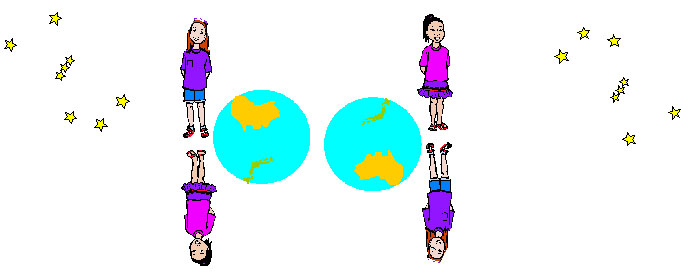
日本とオーストラリアでは同じ星が見えるでしょうか?
日本から見たときに、南の空に見える星ならオーストラリアからも見ることができます。
(夏:さそり座 冬:オリオン座 など)
では、オーストラリアからオリオン座を眺めると、どう見えるでしょうか?
日本からの見え方と同じように見えるでしょうか?
用意するもの
パソコン、オリオン座の図、プロジェクター、日本から見たオリオン座の写真、世界地図または地球儀
やってみよう
- 日本から見たオリオン座の写真を確認します。
- 教室を地球だと考えて、教室の前側を北半球側、後ろ側を南半球側として分けます。 教室を地球に見立てたので、教室の天井は「空」ということになります。
- 教室の天井にオリオン座をプロジェクターで映します。このとき、教室の北半球側(前側)から見て、いつも日本で見ているオリオン座の見え方になるように映すようにします。天井に映されたオリオン座の図をスケッチしておきましょう。
- 今度は教室の南半球側(後ろ側)に移動して、天井に映されたオリオン座の図を見てみましょう。そして見えたオリオン座の図をスケッチしましょう。
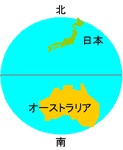 |
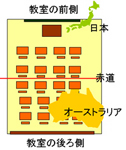 |
| 日本は北半球、オーストラリアは南半球にある。 | 教室を地球に見立ててみると、教室の前側が北半球・後ろ側が南半球ということになる。 |
実験結果
逆さのオリオン座
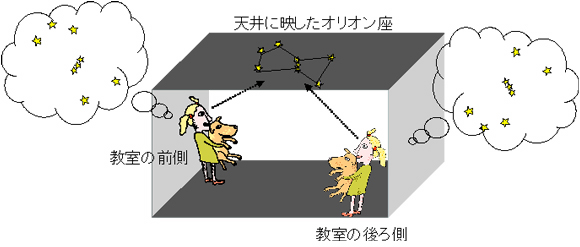
教室の前側(日本のある北半球側)から見たオリオン座は普段見ているオリオン座ですが、教室の後ろ側(オーストラリアのある南半球側)から見たオリオン座は日本で見るものと逆さまになって見えました。
図と写真
 |
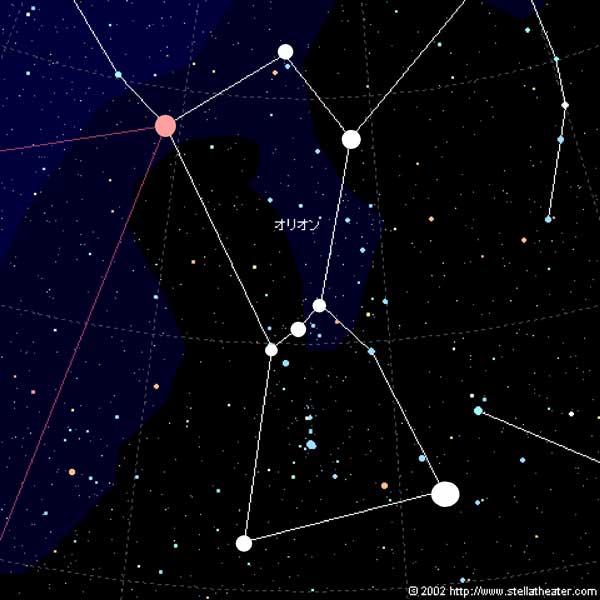 |
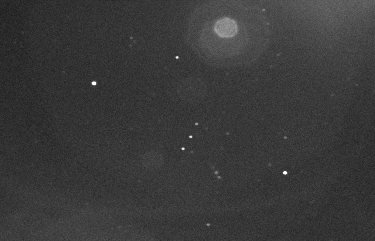 |
| オリオン座のイラスト | オリオン座の図 (クリックすると大きくなります) |
オリオン座の写真 2002.12.17 宮城教育大学屋上 冷却CCDカメラで撮影 (撮影者 吉田和剛) (クリックすると大きくなります) |
 Visibility of the Stars 2
Visibility of the Stars 2
Introduction
Here we will show that changing the observing latitude alters both the appearance of constellations, and the constellations which can be seen
To understand how the appearance of the night sky changes with latitude, we need to move on from the concept of observing the celestial sphere from the Earth's surface, and instead imagine looking down on an observer standing on the surface of the Earth from a point in space.
However, understanding the concept will be the most difficult part of this experiment. With the aid of a model, and by acquiring images of the night sky, it will be possible to appreciate the way its appearance changes with location.
Here we make a drawing of Orion and use a projector to produce an image of it on the ceiling of the classroom. Pupils in different locations in the room will see it in different ways.
We can imagine the whole classroom to be the Earth, with the front half being the northern hemisphere, the rear half being the southern hemisphere, and the whole ceiling being the celestial sphere. When pupils look at the projected image of Orion on the ceiling, those at the rear of the class will see it upside down.
Hence, this experiment illustrates the different views of the stars obtained from the northern and southern hemispheres.
Experimental Method
Is the appearance of constellations the same from different locations?

Are the same stars visible in Japan and Australia?
As seen from Japan, stars which are visible in the southern part of the sky will also be visible in Australia.
(e.g. Scorpius in summer, and Orion in winter)
So, when Orion is observed from Australia, how will it appear?
Will it look the same as it does from Japan?
Things to Prepare
Computer; Figure of Orion; Projector; Photo of Orion as observed from Japan; World map or globe
Experimental Procedure
- Acquire a photo of Orion as seen from Japan
- Using the classroom to represent the Earth, divide it up so that the front half is the northern hemisphere side and the rear half is the southern hemisphere side.
As the classroom represents the Earth, so the ceiling will be the sky.
- The Orion figure is projected onto the ceiling of the classroom with the projector. First, let us think about how the Orion figure appears from the front, i.e. northern hemisphere, side of the classroom, in order to appreciate the way in which Orion appears from Japan. Pupils near the front should try sketching the way the projected figure of Orion appears to them.
- Next, we will consider the way in which the projected figure of Orion appears from the rear, or southern hemisphere, side of the classroom. Now pupils at the back should sketch the way in which they observe the Orion figure
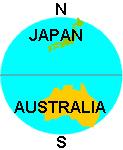 |
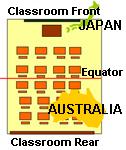 |
| Japan is in the northern hemisphere, while Australia is in the southern hemisphere. | Using the classroom to represent the earth, the front half is the northern hemisphere and the rear half is the southern hemisphere. |
Experimental Results
Upside-Down Orion
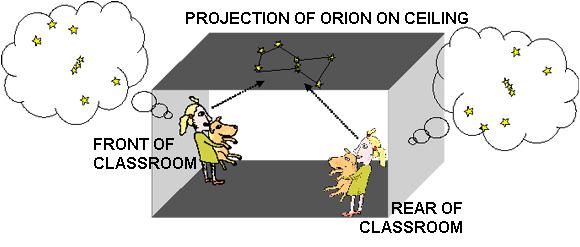
From the front of the classroom (on the northern hemisphere side, representing the view from Japan) the projected view of Orion looked the same as the way Orion usually appears, but from the back of the classroom (on the southern hemisphere side, representing the view from Australia) the projected view of Orion was upside-down compared with with way it is normally seen.











